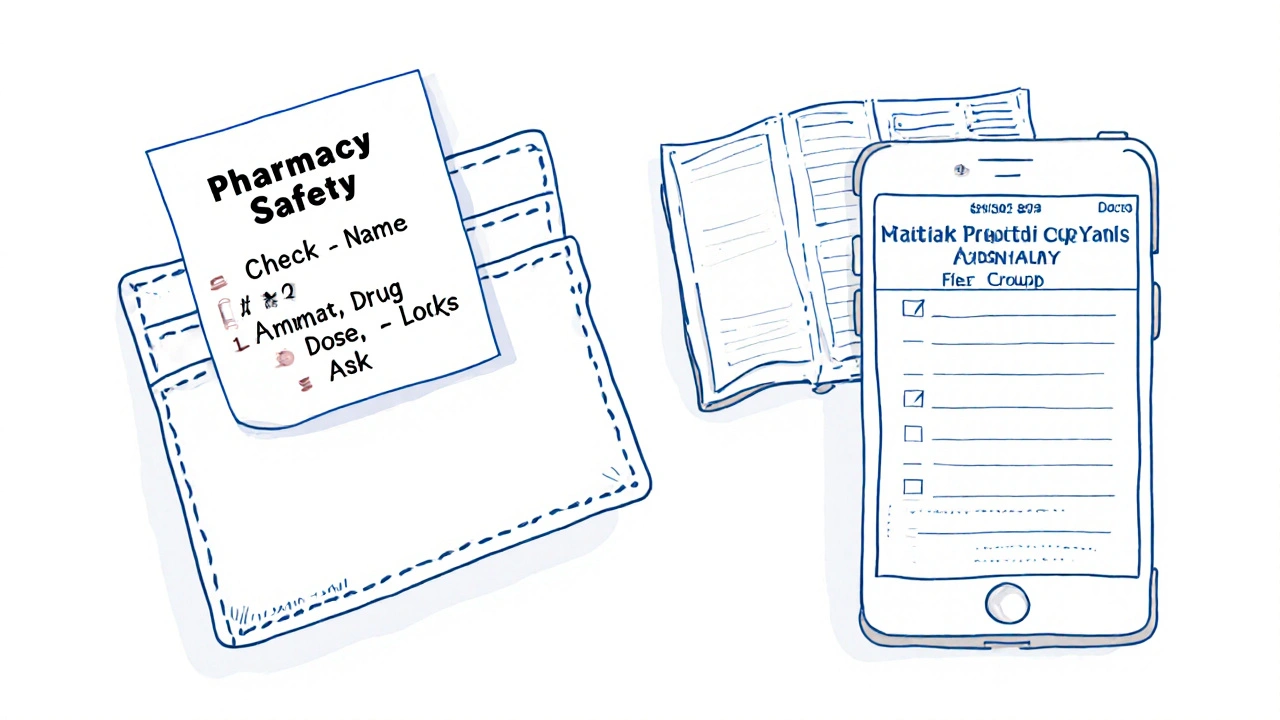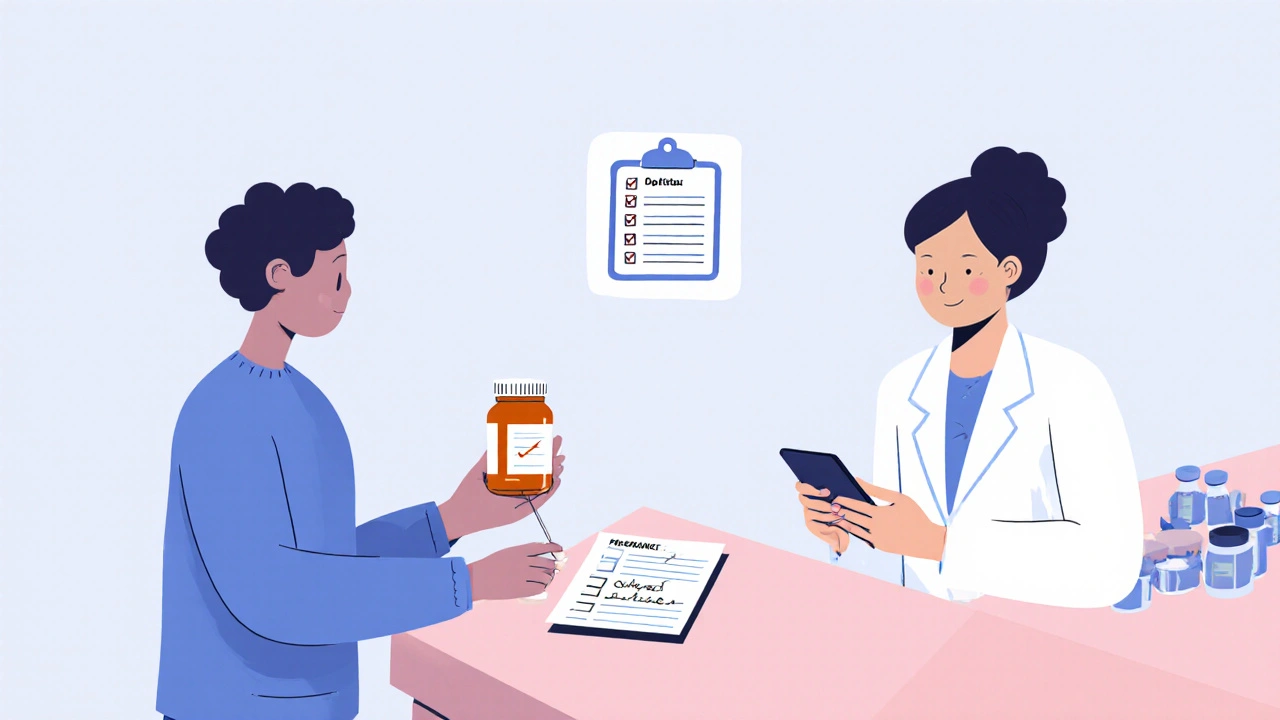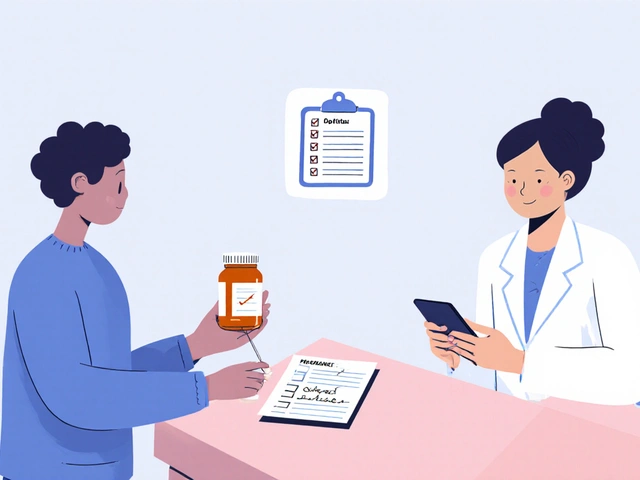Every year, hundreds of thousands of people in the U.S. get the wrong medication, wrong dose, or wrong instructions at the pharmacy. Most of these errors are avoidable. And while pharmacists are trained to catch them, mistakes still happen - especially when you’re picking up a new prescription, multiple medications, or something you’ve never taken before. You don’t need to wait for someone else to fix it. You can protect yourself with a simple, practical checklist you use every time you walk into the pharmacy.
Why You Need a Personal Safety Checklist
Pharmacies are busy. Pharmacists juggle dozens of prescriptions at once. A misread name, a similar-looking drug label, or a rushed refill can lead to a dangerous mistake. One study found that nearly 1 in 5 medication errors happen during dispensing - and many go unnoticed because patients don’t check what they’re given.
You’re not responsible for the pharmacy’s system. But you are responsible for your own safety. Think of this checklist like buckling your seatbelt. You don’t expect the car to crash, but you still do it every time. Same here.
Your 5-Step Pharmacy Safety Checklist
Here’s what to do every single time you pick up a prescription - no exceptions.
- Verify your name and date of birth - Before the pharmacist hands you the bottle, ask: "Is this for [Your Full Name] and do you have my birthdate as [Month/Day/Year]?" Many errors happen because someone else’s prescription gets mixed in. This step catches 70% of identity mix-ups.
- Check the drug name and strength - Look at the label. Compare it to the prescription slip your doctor gave you, or the name you remember from your last refill. If it says "Metoprolol 50 mg" but you were expecting "Metoprolol 25 mg," stop. Ask why it changed. Don’t assume it’s a typo.
- Confirm the dosage instructions - Read the label out loud: "Take one tablet by mouth twice daily with food." Now ask the pharmacist: "Is this what my doctor told me?" Sometimes instructions change without you knowing - like switching from "take at bedtime" to "take in the morning."
- Ask about new or changed medications - If this is a new drug, or if your dose changed, ask: "What is this for?" and "What side effects should I watch for?" If you’re on five or more medications, ask: "Could this interact with anything else I take?" Don’t be shy. Pharmacists are trained to answer this.
- Inspect the pills or liquid - Compare the shape, color, and imprint on the pill to your last refill. If it looks different, ask: "Is this the same medicine?" Some generic brands look totally different but are chemically identical. But if the color changed from blue to red and you’ve never seen it that way before, it’s worth asking. For liquids, check the smell and clarity. If it looks cloudy or smells off, say something.
What to Bring to the Pharmacy
Don’t rely on memory. Show up prepared.
- A current list of all your medications - including over-the-counter drugs, vitamins, supplements, and herbal products. Use the free MedList app from the FDA or write it out by hand.
- Your doctor’s prescription slip or a photo of it on your phone. Even if the pharmacy has it on file, having it on hand helps you catch mismatches.
- A list of questions you want to ask. Write them down ahead of time. People forget half their questions when they’re nervous.
- A notepad or phone to take notes. If the pharmacist gives you new info, write it down. You’ll thank yourself later.
Red Flags That Mean Stop and Ask
These signs mean something’s wrong - don’t ignore them.
- The pill looks nothing like your last bottle - even if it’s the same name.
- The label says "take once daily" but your doctor said twice.
- You’re being handed a controlled substance (like oxycodone or Adderall) and no one asked for ID.
- The bottle says "for diabetes" but you don’t have diabetes.
- The pharmacist seems rushed, distracted, or dismissive when you ask questions.
If any of these happen, say: "I’m not comfortable taking this. Can we double-check?" Then wait. Don’t leave until you’re sure.
What to Do If You Notice an Error
If you catch a mistake - whether it’s the wrong drug, wrong dose, or wrong instructions - don’t just walk away. Do this:
- Stay calm. Say: "I think there might be an error here. This doesn’t match what my doctor prescribed."
- Hand them your prescription slip or medication list.
- Ask them to call your doctor to confirm.
- Request a printed copy of the corrected label.
- If they refuse to fix it, go to another pharmacy. Report it to the state board of pharmacy. You have the right to safe medication.
Pharmacies are required to correct errors. You’re not being difficult - you’re doing your job as a patient.
How to Make This a Habit
Most people only use a checklist once - then forget. Here’s how to make it stick.
- Put a sticky note on your wallet or phone: "Check Name, Drug, Dose, Looks, Ask."
- Set a reminder on your phone: "Pharmacy Safety Check - Every Visit."
- Teach a family member - especially if you’re managing meds for an elderly parent.
- Keep a small log: write down each visit, what you checked, and if anything was off. Over time, you’ll spot patterns.
After three months, you won’t even think about it. It’ll just be part of the routine - like checking your pockets before leaving the house.

Why This Works - Real Examples
One woman in Houston picked up her blood pressure med and noticed the pill was yellow instead of white. She asked. Turns out, the pharmacy filled her husband’s prescription - same name, same last name, same birthday. They’d mixed them up. She didn’t take it. They fixed it.
A man in Dallas got his insulin refill and saw the dose was 10 units instead of 5. He’d been on 5 for two years. He asked. The pharmacist admitted the system auto-filled it based on an old order. He caught it before he injected the wrong amount.
These aren’t rare. They happen every day. And they’re preventable.
What You Can’t Do - And What You Can
You can’t verify a pharmacy’s inventory system. You can’t check if their temperature logs are up to date. You can’t audit their staff training. Those are their responsibilities.
But you can verify what’s in your hand. You can ask if it matches what your doctor ordered. You can speak up when something feels off. That’s your power. And it’s enough.
Medication safety isn’t just the pharmacist’s job. It’s a team effort. And you’re the most important member of that team.
Do I need a checklist if I’ve been taking the same medicine for years?
Yes. Even long-term meds can be switched accidentally. Generic versions change shape, color, or size. Doses get updated. Your doctor might have changed your prescription without telling you. Always verify - even if it’s been the same for 10 years.
Can I ask the pharmacist to explain my medication even if I’ve taken it before?
Absolutely. Pharmacists are required to offer counseling on new prescriptions, but you can ask for it anytime. Say: "I’d like to make sure I’m still taking this correctly." They won’t mind. In fact, they’ll appreciate you being engaged.
What if the pharmacy says my doctor didn’t change anything, but I’m sure they did?
Ask the pharmacist to call your doctor’s office and confirm. If they refuse, go to another pharmacy. Your safety matters more than their convenience. You have the right to get the right medication.
Is it okay to take a photo of the label for my records?
Yes. Most pharmacies don’t have a problem with it. A photo of the label, the bottle, and your prescription slip can be lifesaving if you need to show it to another provider or report an error later.
Should I bring someone with me to the pharmacy?
If you’re on multiple medications, have memory issues, or feel overwhelmed, yes. A second set of eyes helps catch things you might miss. Even if they’re not a medical expert, they can ask: "Wait, is that the same as last time?"
Next Steps: Start Today
Don’t wait for something to go wrong. Print out your own version of this checklist. Put it in your wallet. Set a reminder. Use it the next time you pick up a prescription - even if it’s just for ibuprofen.
Pharmacies won’t hand you a safety checklist. No one will train you to use one. But you don’t need permission to protect yourself. You just need to start.



Robert Merril
November 16, 2025 AT 19:50So let me get this right I gotta check my name my birthdate the drug the dose the color of the pill and then ask if it smells right and if the pharmacist is having a bad day all before i take a fucking ibuprofen
Jesus christ next theyll make me sign a waiver to buy aspirin
But honestly yeah i did once get a blue pill instead of white and didnt say anything until i threw up for three hours
So maybe this checklist isnt dumb
Just inconvenient as hell
Also the pharmacist looked at me like i was crazy when i asked if the bottle was for me
Turns out it was for my neighbor who has the same last name
So yeah check your shit
And if they roll their eyes tell them youve seen the news
Also i wrote all this on my phone and it auto corrected half of it so sorry if its a mess
Noel Molina Mattinez
November 17, 2025 AT 06:34Why are you putting all this burden on patients
Pharmacists get paid to do this
Its not my job to be a drug inspector
Im not a nurse
Im not a doctor
I just want my pills
Why do we keep doing this
Its the system
Not me
Roberta Colombin
November 18, 2025 AT 06:48Thank you for writing this with such care and clarity
I work with older adults who often feel too shy to ask questions at the pharmacy
This checklist gives them a simple script to follow
And it reminds them they are not being difficult
They are being smart
I print this out and give it to every family I work with
Even my own mother uses it now
She says it makes her feel safer
And that matters more than anything
Thank you for making safety feel normal not scary
Dave Feland
November 19, 2025 AT 22:38This checklist is a pathetic bandaid for a catastrophic failure of pharmaceutical regulation
The fact that you need to verify your own medication at the point of dispensing is a systemic indictment of the entire U.S. healthcare infrastructure
Pharmacies are profit-driven entities with zero accountability
They use automated systems that misread handwritten scripts
And then they blame the patient for not catching their errors
Meanwhile the FDA approves generics with wildly different appearances
And no one audits the error rates
This checklist is not empowerment
It is survival
And it should not be necessary
Ashley Unknown
November 21, 2025 AT 18:36Okay so imagine this
You go to the pharmacy
You check your name
You check the pill
You check the dose
You ask if it interacts with your other meds
And then the pharmacist says oh wait this is actually for your dead uncle
And you realize your name is on the list of people who died last year
And the pharmacy system still thinks you are dead
And now you have to fight to prove you are alive
And they have to manually override the death flag
And you have to call your doctor
And your insurance
And your cousin who works at the state database
And by then you are crying in the parking lot
And the whole thing was because someone typed your name wrong in 2012
And now you have to carry this checklist everywhere
Because the system is broken
And you are the only one who can fix it
And you are so tired
Georgia Green
November 23, 2025 AT 14:47I use this checklist every time
Especially since my dad had that mixup with the blood thinner
He thought the new pills were the same because the bottle said the same name
But the shape was different
Turns out the generic switched
I wish I had known to check earlier
Now I always look at the pill
And I take a picture
And I write down the date
Its just habit now
And I tell my friends
Its not paranoid
Its just smart
Christina Abellar
November 25, 2025 AT 08:26This is exactly what we need
Simple
Clear
No judgment
Just facts
Thank you
Eva Vega
November 25, 2025 AT 12:45Adherence to the National Association of Boards of Pharmacy (NABP) dispensing protocol mandates that the pharmacist perform a final verification of patient identity and medication reconciliation prior to dispensing
However, the absence of mandatory electronic health record (EHR) interoperability between prescribers and pharmacies creates a systemic vulnerability
Thus, patient-initiated verification serves as a critical fail-safe in the absence of standardized clinical decision support
It is not a burden
It is a necessary risk mitigation strategy
Given the high incidence of polypharmacy and medication reconciliation errors in ambulatory care
Patient engagement is not optional
It is a core component of pharmacovigilance
Matt Wells
November 26, 2025 AT 02:15It is both regrettable and indicative of a broader cultural decline that the average citizen must now act as a de facto pharmaceutical auditor
One cannot help but note the irony that in a nation which prides itself on technological advancement, the most reliable safeguard against lethal error remains a handwritten list and a patient with a modicum of vigilance
It is a testament to the incompetence of the healthcare industrial complex
And yet, one is left with no alternative but to comply
One wonders how many lives have been lost because patients assumed the system would protect them
It will not
It never has
And so we are forced to become our own guardians
Margo Utomo
November 28, 2025 AT 00:19YES YES YES 🙌👏 this is literally the most important thing you’ll ever do for your health
I used to think I was being annoying
Now I know I’m being a superhero 💪💊
My grandma is 82 and takes 12 meds
She uses this checklist and now she calls me every time something looks weird
And I love it
She’s alive because she asked
So please please please share this with everyone you know
Even if they think it’s silly
It’s not silly
It’s saving lives 🌟
George Gaitara
November 28, 2025 AT 01:46Why are we even talking about this
Someone should have sued the pharmacy after that Houston mixup
And why is this post so long
It’s just pills
People are too scared to take meds
Now we have this checklist
Next thing you know
We’ll need a notary to sign our Tylenol bottles
And a 10-page consent form for Advil
Stop making everything a crisis
Just take your damn medicine
Deepali Singh
November 28, 2025 AT 23:18According to CDC data from 2022, 70% of medication errors occur during dispensing in community pharmacies
Yet only 12% of patients report verifying their prescriptions
The psychological barrier to questioning authority figures in healthcare is statistically significant
And the normalization of patient compliance as passive obedience is a structural flaw
This checklist is a micro-resistance
But it is not a solution
It is a symptom
And the disease is the commodification of health